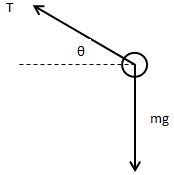Assignment:
Part 1: Varying Masses
1. Measure all three masses on a scale, in kilograms. A standard bathroom scale may not have the precision to weigh the smaller objects, so you'll probably have to use a kitchen scale. Be sure to convert the mass in grams or pounds to kilograms! Look up the conversion factor between kg and lb if necessary. Record the three objects and their masses below.
2. Measure off 0.5 m of string and tie one end to the medium-mass object. If you only have a yardstick or a ruler that doesn't measure in cm, you can do a Metric conversion.
3. Tie the medium-mass object to one end of the string. Swing it above your head in a circular motion. Try not to move your hand too much. Measuring time with the stopwatch, how many full revolutions can you make the object do in 10 seconds? It may help to have a friend standing nearby to do the counting. (Just make sure not to accidentally whack them in the head.)
4. Repeat Step 3 for the other two masses, and record your results below.
5. Since there are 2π radians in a full revolution, you can calculate the angular velocity ω of the object with the equation
(1) ω= Δθ/Δt=2π radians*# revolutions/10 s
Calculate the angular velocity of all three masses below. Make sure to include the correct units in your calculations.
6. The linear velocity of an object in uniform circular motion is given by
(2) v= ωr
where r is the radius of the circle (length of the string). Use this to calculate the tangential velocity of the three masses below.
7. The centripetal acceleration of a rotating object is given by
(3) ac=rω2
Use this to calculate the centripetal acceleration of the three masses below. Are any of them greater than gravitational acceleration (9.8 m/s2)?
Part 2: Varying Radius
1. For the medium mass, increase the length of the string to 0.75 m and repeat Step 3 of Part 1. Calculate the angular velocity ω of the mass below.
2. Now increase the length of the string to 1m and repeat Step 3 of Part 1. Calculate the angular velocity of the mass below.
3. You can calculate the centripetal force necessary to keep the mass moving in a circle.
(4) Fc=mac=mrω2
Calculate it below for all three lengths of string. Are the three centripetal forces close to the same, or fairly different?
4. Did you feel the string pulling on your hand as you were swinging it? What kind of force is in the string, pulling on both your hand and the swinging mass? From what we know about this type of force, how does the size of the force on the mass compare to the force on your hand?
Part 3: The Bigger Picture
1. You may have noticed during the lab that the string was not completely horizontal, instead dipping some. This is due to the force of gravity pulling the mass down, so everything that we have been doing up to this point was an approximation. We can draw a free-body diagram of the situation, with centripetal force and gravity acting on the swinging mass.

From equating vertical components,
(5) T sin?θ=mg
The horizontal component of the tension in the string will produce the centripetal force, and the radius of the circular path is actually the horizontal component of the string length, so
(6) Fc= Tcos?θ= m ω2 L cos?θ
where θ angle that the string dips below the horizontal and L is now the length of the string. We can simplify this to
(7) T=m ω2 L
Use these equations to calculate the dip angle of the medium mass when the string has a length of 0.75 m, using the appropriate ω from Step 1 of Part 2. (Hint: Calculate T from Eq. (7), then plug into Eq. (5) and solve for θ.)
2. Astronauts and fighter pilots undergo centrifuge training to ensure they can withstand high accelerations. It works on the same principles we've studied here.The astronaut sits in a seat at the end of a long beam, and experiences centripetal acceleration as the training apparatus spins. Using the equations given in this lab, calculate what angular velocity would be needed to give a person 9g (9 times Earth gravity) of centripetal acceleration if they moved in a circle of radius 10 m.